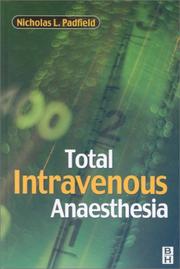| Listing 1 - 10 of 15 | << page >> |
Sort by
|
Book
Year: 1946 Publisher: Paris : Masson,
Abstract | Keywords | Export | Availability | Bookmark
 Loading...
Loading...Choose an application
- Reference Manager
- EndNote
- RefWorks (Direct export to RefWorks)
Book
ISBN: 0443020728 Year: 1988 Publisher: Edinburgh ; New York : Churchill Livingstone,
Abstract | Keywords | Export | Availability | Bookmark
 Loading...
Loading...Choose an application
- Reference Manager
- EndNote
- RefWorks (Direct export to RefWorks)
Book
Year: 1969 Publisher: Aarhus : Universitetsforlaget = Norwegian universities press,
Abstract | Keywords | Export | Availability | Bookmark
 Loading...
Loading...Choose an application
- Reference Manager
- EndNote
- RefWorks (Direct export to RefWorks)
ANESTHESIA, CONDUCTION --- ANESTHESIA, INTRAVENOUS --- ANESTHESIA, CONDUCTION --- ANESTHESIA, INTRAVENOUS
Book
ISBN: 0815101066 Year: 1980 Publisher: Miami : Symposia Specialists,
Abstract | Keywords | Export | Availability | Bookmark
 Loading...
Loading...Choose an application
- Reference Manager
- EndNote
- RefWorks (Direct export to RefWorks)
Anesthesiology --- Intravenous anesthesia. --- Anesthesia, intravenous
Dissertation
Year: 1991 Publisher: Amsterdam s.n.
Abstract | Keywords | Export | Availability | Bookmark
 Loading...
Loading...Choose an application
- Reference Manager
- EndNote
- RefWorks (Direct export to RefWorks)
Anesthesia, Intravenous --- Droperidol --- Etomidate --- Fentanyl

ISBN: 0750641711 Year: 2000 Publisher: Oxford : Butterworth-Heinemann,
Abstract | Keywords | Export | Availability | Bookmark
 Loading...
Loading...Choose an application
- Reference Manager
- EndNote
- RefWorks (Direct export to RefWorks)
Anesthesia, General. --- Anesthesia, Intravenous. --- Intravenous anesthesia.
Book
ISBN: 0443009775 Year: 1974 Publisher: Edinburgh : Churchill Livingstone,
Abstract | Keywords | Export | Availability | Bookmark
 Loading...
Loading...Choose an application
- Reference Manager
- EndNote
- RefWorks (Direct export to RefWorks)
Anesthesiology --- Anesthesia, Intravenous. --- Intravenous anesthesia --- Anesthesia, Intravenous --- IV anesthesia --- Anesthesia --- Anesthesias, Intravenous --- Intravenous Anesthesia --- Intravenous Anesthesias --- Intravenous anesthesia. --- Anesthesiology. --- Anesthesia, intravenous
Book
Year: 2009 Publisher: Bruxelles: UCL,
Abstract | Keywords | Export | Availability | Bookmark
 Loading...
Loading...Choose an application
- Reference Manager
- EndNote
- RefWorks (Direct export to RefWorks)
The molecular mechanisms of general anaesthetics have remained largely obscure since their introduction into clinical practice just over 150 years ago. Many theories have tried to explain their mechanisms. The oldest one was the Myer-Overton correlation. They had found a correlation between the potency of an anaesthetic and her lipid solubility. But since 1980, the ligand-gated ion channels theory seems to be currently the best explanation. According to that theory, the ligand-gated ion channels are the best targets at clinical concentration of the general anaesthetics. GABAA receptors are the best candidates because of their ubiquitary distribution in the central nervous system, theirs essentials physiological roles and their sensibility to many agents at clinical concentrations. Other receptors like glutamate, glycine, serotonin-3 or nicotinic acetylcholine receptors are also targets of general anaesthetics. Finally, sodium, potassic and calcium channels are also recognized as important targets of general anaesthetics. The oxygen pathway perturbation hypothesis allows to explain several anaesthetics effects but it doesn’t seem to catch the attention in the researches Les mécanismes moléculaires des anesthésiques généraux sont restés longtemps obscures depuis leur introduction dans la pratique Clinique il y a 150 ans. Plusieurs es ont été proposées pour essayer d’expliquer leurs modes d’action. Une des plus anciennes fut la théorie de Meyer-Overton. Elle établit une corrélation entre la puissance d’un anesthésique et sa liposolubilité. Depuis les années 1980 la théorie des canaux ioniques couplés à des récepteurs semble être la meilleure explication actuellement. Selon cette dernière, les canaux ioniques couplés à des récepteurs sont les cibles privilégiées des agents anesthésiques aux concentrations cliniques. Parmi ces récepteurs, les GABAA sont les meilleurs candidats en raison de leur distribution ubiquitaire au niveau du système nerveux central, de leurs rôles physiologiques essentiels et de leur sensibilité à de nombreux agents aux concentrations cliniques. Il fut également établi que d’autres récepteurs canaux comme les récepteurs du glutamate, de la glycine de la sérotonine-3 ou encore les récepteurs nicotiniques de l’acétylcholine étaient aussi des cibles des agents anesthésiques ainsi que les canaux sodiques, potassiques et calciques. L’hypothèse de la perturbation du trajet de l’oxygène permet d’expliquer plusieurs effets des anesthésiques, mais elle ne semble pas encore vraiment retenir l’attention dans les recherches
Anesthesia, General --- Anesthesia, Inhalation --- Anesthesia, Intravenous --- Ion Channel Gating
Dissertation
Abstract | Keywords | Export | Availability | Bookmark
 Loading...
Loading...Choose an application
- Reference Manager
- EndNote
- RefWorks (Direct export to RefWorks)
Propofol --- Alfentanil --- Abdomen --- Anesthesia, Intravenous --- Computers --- pharmacology --- pharmacology --- surgery
Dissertation
Year: 1986 Publisher: Leiden s.n.
Abstract | Keywords | Export | Availability | Bookmark
 Loading...
Loading...Choose an application
- Reference Manager
- EndNote
- RefWorks (Direct export to RefWorks)
Anesthesia, Inhalation --- Anesthesia, Intravenous --- Fentanyl --- Nitrous Oxide --- blood --- administration & dosage
| Listing 1 - 10 of 15 | << page >> |
Sort by
|

 Search
Search Feedback
Feedback About UniCat
About UniCat  Help
Help News
News